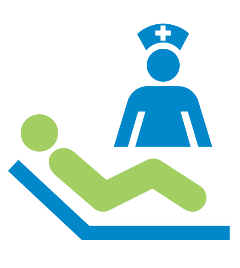Senior Living 101: Your Quick Guide to the World of Senior Care Options

Your Quick Guide to the World of Senior Care Options
Do you know the difference between assisted living and independent living? How about hospice and palliative care? What even is an adult day care center?
If you don’t know the answers to these questions, you’re not alone.
The spectrum of senior care options is crowded and complicated. Sometimes, these services overlap; their availability might vary by provider or state. In this quick guide, we’ll offer a basic overview of each option so you can start your search with a clearer understanding of what’s out there. Keep in mind that this list only scratches the surface — reach out to us if you have questions!
This guide covers:
- Home care
- Adult day services
- Assisted living
- Independent living
- Nursing homes
- Memory care
- Continuing care
- Hospice & palliative care
These senior care options differ based on the associated living situation as well as the level of care provided.
Before we dive in, let’s define some key terms: “activities of daily living” (ADLs) and “instrumental activities of daily living” (IADLs). These daily life tasks are what define the levels of assistance and support an older adult requires in various care settings, particularly assisted living.
 ADLs: These are the basic skills required for daily living. For example: eating, bathing/grooming, dressing, using the bathroom and continence management, and transferring (in and out of bed or chairs).
ADLs: These are the basic skills required for daily living. For example: eating, bathing/grooming, dressing, using the bathroom and continence management, and transferring (in and out of bed or chairs).
 IADLs: These skills are more complex but are fundamental to living independently. For example: cleaning and maintaining the house, managing money, scheduling appointments, making social phone calls or engagements, and preparing meals.
IADLs: These skills are more complex but are fundamental to living independently. For example: cleaning and maintaining the house, managing money, scheduling appointments, making social phone calls or engagements, and preparing meals.
Senior Care Options for Living at Home
1. Home Care
Home care, also known as skilled health or companion care, refers to medical services provided in a person’s home by a professional such as a licensed nurse. This can include health-related specialty services like IV care, catheter care and wound care. Medication management — such as medication reminders — may be included depending on the agency’s capacity. Medication administration would be handled by a nursing professional.
Services provided by a professional caregiver like a certified nurse’s aide (CNA) would include assistance with ADLs, like dressing, showering, eating, or moving around.
This senior care option also encompasses a range of non-skilled services, such as help with laundry, housekeeping and meals, as well as simple companionship and escorted transportation.
Home care: services provided in the senior’s home, including medical, housekeeping and “activities of daily living” (ADLs). High support.
 2. Adult Day Services
2. Adult Day Services
Adult day centers offer activities, meals and social interaction for older adults during daytime hours. Some centers may provide assistance with activities of daily living (ADLs) and medication assistance, or transportation to/from the center. Seniors who leverage this senior care option typically live at home.
Adult day services: activities, meals and social interaction during daytime hours. Limited support.
Options for Community Living with Moderate Support
3. Assisted Living
Assisted living or personal care settings offer private and semi-private apartments and a range of services for older adults who require assistance with ADLs and IADLs. The spectrum of support is flexible to meet a low to higher level of needs. These settings typically include three meals per day, a rich program of activities and experiences and transportation.
Assisted living: apartment living with activities, meals and assistance with ADLs and IADLs. Flexible support.
 4. Independent Living Communities
4. Independent Living Communities
Residents in these settings can manage life on their own with or without help, reside in private apartments, townhomes, or single-family homes, and enjoy a low-maintenance lifestyle. They have access to a wide range of social activities, meal plans, and other community-based amenities like a fitness center or pool.
In some cases — and depending on the regulatory environment in the state — a resident in independent living may engage home care for ADLs and IADLs. This would elevate this senior care option to a higher level of support.
Independent living: low-maintenance apartment & home living with social activities and amenities. Low support.
Options for Facility Living with High Support
5. Nursing Homes
Nursing homes, skilled nursing facilities or skilled nursing and rehab centers are highly specialized care centers. This senior care option is for individuals that require round-the-clock on-site supervision. They offer full health support, cover all basic necessities, assist with ADLs and provide highly personal care. All medical care is supplied by nurses and other licensed clinical professionals.
Nursing homes: round-the-clock supervision with full services and medical care. High support.
6. Memory Care
Alzheimer’s or dementia-specific care usually offers 24-7 supervision in a secured setting. This care may be either stand-alone or part of a larger assisted living residence, nursing facility, or retirement community. Experienced memory care communities even go beyond everyday care to include programs designed to stimulate the mind, strengthen the body and nourish the spirit.
Memory care: specialized nursing homes with memory-specific activities and security. High support.
 7. Continuing Care
7. Continuing Care
Continuing care includes programs like LifeCare, LifePlan, or Continuing Care Retirement Communities (CCRCs). Multiple levels of care are available at this senior care option.
It’s very common for residents of these type of communities to pay an up-front entrance fee for their independent living apartment, plus monthly fees. As they age in place, they move through the available spectrum based on care needs, be it to assisted living, memory care, or skilled nursing.
As they scale in needs, their monthly fees may increase from the initial fee, or remain relatively stable (subject to annual increases) depending on the type of contract signed. There are financial and emotional advantages to this type of care setting because of the associated stability.
Continuing care: aging in place with a sliding scale of support from independent living to skilled nursing. Flexible support.
Hospice and Palliative Care Options
 3. Hospice and Palliative Care
3. Hospice and Palliative Care
Hospice and palliative care are slightly different from the other senior care options we’ve covered, and there are also key differences between them.
These services are typically delivered at the end of life or during a period of extended illness in a person’s home. This can be in a stand-alone hospice community, or in a nursing home, assisted living, or independent living apartment.
Palliative care specifically can begin at the time of diagnosis and can be delivered alongside other life-saving or life-sustaining treatments. Examples of palliative care measures include medication, occupational therapy, nutritional guidance, counseling, support groups, and more.
Hospice & palliative care: end-of-life or illness, across a variety of facilities. High support.
Timing
Hospice care is usually based on the idea that the individual has less than 6 months to live. However, if it is determined the resident would like only care and comfort measures, rather than full medical support, the conversation will usually include hospice. Sometimes the hospice patient’s condition improves and hospice care can be discontinued.
 Eligibility
Eligibility
Older adults receiving Medicare are entitled to a hospice benefit if they qualify for services. Many are unaware of this fact, so the services become part of an individual’s plan of care later than they should. If you think this may apply to you or your loved one, it’s important to learn more about Medicare hospice benefits (including how to find a provider, what services are covered, and who’s eligible) and start conversations earlier to access the benefits of this important care resource.
Choosing the Right Option
At the end of the day, you and your family will have the best sense of which option is right for you. This guide is here to help you navigate the different senior care options and terms that you’ll come across, but it’s really just the start of your journey to choosing the right care option.
The big takeaway to remember here is that senior care options differ primarily based on:
- Level of care
- Living situation
Those two factors will help you narrow down the type of care you or your loved one may need now and in the future.
If you’re just starting this journey, consider taking this 5-minute survey to assess your situation and determine whether it’s the right time for senior living for you or your loved one.


